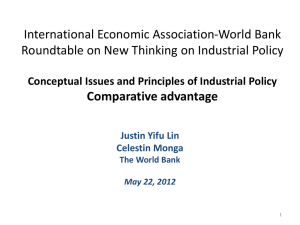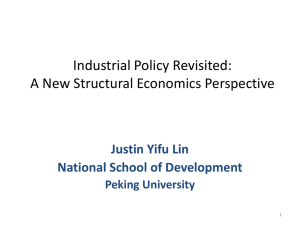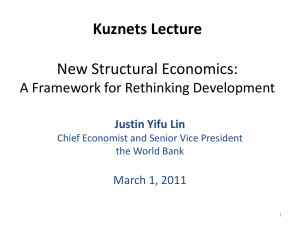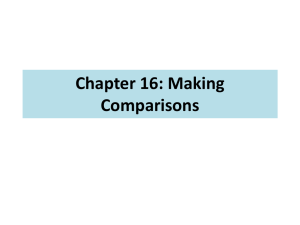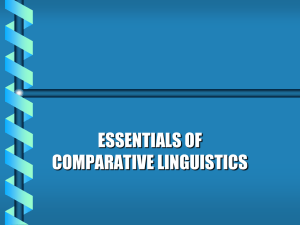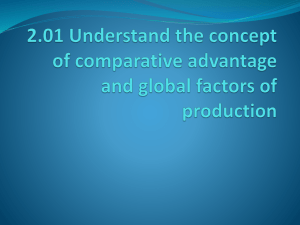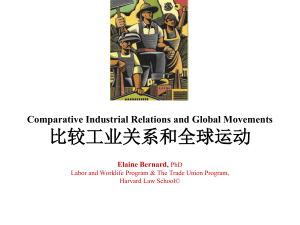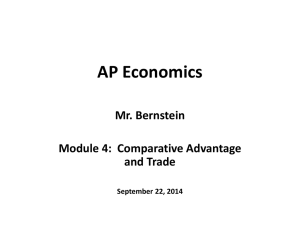sector-targeted industrial policy
advertisement
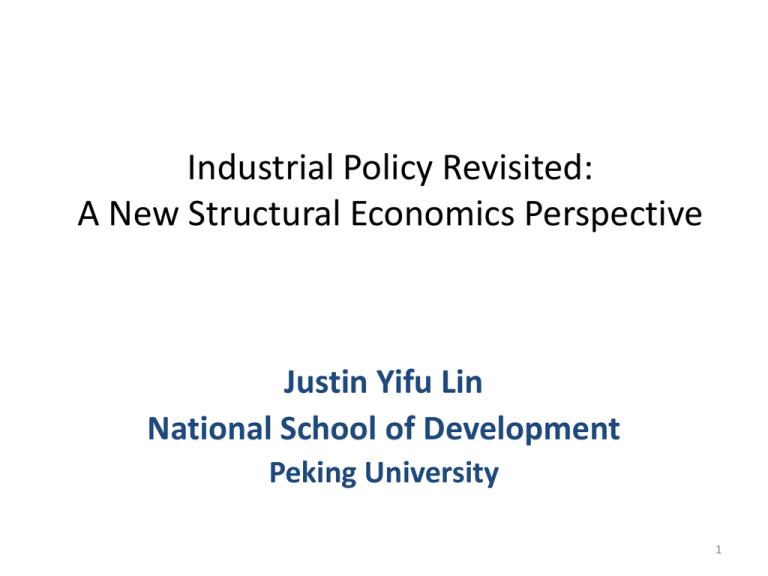
Industrial Policy Revisited: A New Structural Economics Perspective Justin Yifu Lin National School of Development Peking University 1 Main Messages • A sector-targeted industrial policy is essential to achieve dynamic structural change and rapid, sustained growth in an economy. • Most industrial policies fail because they target industries that are not compatible with the country’s comparative advantage. • Successful industrial policy should target industries that are the country’s latent comparative advantages. • Historical experiences show that successful countries’ industrial policies, in general, targeted industries in countries with a similar endowment structure and somewhat higher per capita income. • The Growth Identification and Facilitation Framework, based on New Structural Economics, is a new, effective way for targeting latent comparativeadvantage industries and supporting their growth. 2 Industrial Upgrading, State Facilitation and Industrial Policy • Modern economic growth is a process of continuous technological innovation, industrial upgrading and economic diversification. • A facilitating state is essential for rapid technological innovation, industrial upgrading, and economic diversification because of the need to: – Address externalities – Solve coordination problems • Industrial policy is a useful instrument for a facilitating state. – Contents of coordination may be different, depending on industries. – The government’s resources and capacity are limited. The government needs to use them strategically. 3 Comparative Advantage Defying and the Failure of Industrial Policy • The sad fact is that almost all governments in the world attempted to use industrial policies to play the facilitating role, but most failed. • The reason is that the government’s targeted industries went against the country’s comparative advantages. – The firms in the industrial policy’s targeted sectors were non-viable in the competitive market. – To support its initial investment and to ensure the firms’ continuous operation, governments supported the non-viable firms through all kinds of subsidies and protections. – Those measures led to a lack of competition and increased rent-seeking. – As a result, the attempts to pick winners ended up picking losers. 4 Latent Comparative Advantage and Picking Winners • For an industrial policy to be successful, it should target sectors that conform to the economy’s latent comparative advantage: – The latent comparative advantage refer to an industry that the economy has low factor costs of production but the transaction costs are too high to be competitive in domestic and international markets – Firms will be viable and the sectors will be competitive once the government helps the firms overcome coordination and externality issues to reduce the risk and transaction costs. • But how can the government pick the sectors that are in line with the economy’s latent comparative advantages? 5 What Can Be Learned From History? • Historical evidences show that successful countries in their catching-up stage all used industrial policies to facilitate their industrial upgrading and their industrial policies targeted industries existing in dynamically growing countries with a similar endowment structure and moderately higher per capita income: – – – – – – – • Britain targeted the Netherlands’ industries in the 16th and 17th centuries; its per capita GDP was about 70% of the Netherlands’. Germany, France, and the USA targeted Britain’s industries in the late 19th century; their per capita incomes were about 60% to 75% of Britain’s. In Meiji restoration, Japan targeted Prussia’s industries; its per capita GDP was about 40% of Prussia’s. In the 1960s, Japan targeted the USA’s industries; its per capita GDP was about 40% of the USA’s. In the 1960s-80s, Korea, Taiwan, Hong Kong, and Singapore targeted Japan’s industries; their per capita incomes were about 30% of Japan’s. In the 1970s, Mauritius targeted Hong Kong’s textile and garment industries; its per capita income was about 50% of Hong Kong’s. In the 1980s, Ireland targeted information, electronic, chemical and pharmaceutical industries in the USA; its per capita income was about 45% of the USA’s. In the 1990s, Costa Rica targeted the memory chip packaging and testing industry; its per capita GDP was about 40% of Taiwan’s, which was the main economy in this sector. Unsuccessful industrial policies, in general, targeted industries in countries where their per capita GDPs were less than 20% of the targeted countries 6 Why did successful industrial policies target industries in dynamically growing countries with a similar endowment structure and somewhat higher income? • Industrial upgrading is based on changes in comparative advantages due to changes in endowment structure. • Countries that have a similar endowment structure should have similar comparative advantages. • A dynamically-growing country’s industries should be consistent with the country’s comparative advantages. Some of its industries will lose comparative advantage as the country grows and its endowment structure upgrades. Those “sunset” industries will become the latent comparative advantage of the latecomers. • For countries with a similar endowment structure, the forerunners’ successful and dynamic industrial development provides a blueprint for the latecomers’ industrial policies. 7 The existing tools and their drawbacks • Business and Investment environment – The idea is based on Washington Consensus and its goal is to introduce a whole set of the first-best institutions – The issues are: • The government may not have the capacity to introduce all those changes • The first-best institutions may be different at different stage of development • No identification of industries with latent comparative advantages and no compensation for the first movers • Growth Diagnostics – It focuses on binding constraints instead of the whole set of first best institutions – It relies on survey of existing firms. Many of them may be in industries where the country has no comparative advantages. – There may be no firms in the new industries that the countries have latent comparative advantage • Product Space – The idea is based on the fact that firms in existing sectors own tacit knowledge that is helpful for successful upgrading/diversification to nearby sectors in the product space – The existing sectors may be wrong sectors due to the wrong interventions in the past. – Some sectors that the country has latent comparative advantage may be totally new to the country and the tacit knowledge can be brought in with FDIs • Randomized Control Trials – Searching for ingredients instead of a recipe 8 Growth Identification and Facilitation Step 1 Find fast growing countries with similar endowment structures and with about 100% higher per capita income. Identify dynamically growing, tradable industries that have performed well in those countries over the last 20 years. Avoid the government doing the wrong things or being captured by vested groups for rent seeking Incorporate the idea of tacit knowledge Step 2 See if some private domestic firms are already in those industries (existing or nascent). Identify constraints to expansion, quality upgrading or further firm entry. Take action to remove constraints 9 Growth Identification and Facilitation Step 3 In industries where no domestic firms are currently present, seek FDI from countries examined in step 1, or organize new firm incubation programs. Import or cultivate tacit knowledge Benefit from opportunities arising from new technologies Step 4 In addition to the industries identified in step 1, the government should also pay attention to spontaneous self discovery by private enterprises and give support to scale up successful private innovations in new industries. 10 Growth Identification and Facilitation Step 5 In countries with poor infrastructure and bad business environments, special economic zones or industrial parks may be used to overcome barriers to firm entry, attract FDI, and encourage industrial clusters. Play the coordination function in a pragmatic way Address the externality issue Step 6 The government may compensate pioneer firms identified above with: • Tax incentives for a limited period • Direct credits for investments • Access to foreign exchange 11 Concluding Remarks • Every developing country has the potential to grow dynamically for decades, and to become a middle-income or even a high-income country in one or two generations, as long as the government has the right industrial policy to facilitate the development of the private sector along the line of the country’s comparative advantages and tap into the latecomer advantages. • For the government’s industrial policy to achieve that desirable result, a change in development thinking is necessary: – In the past the development thinking used the advanced countries as references and advised the developing countries to develop what the advanced countries had but they did not have (modern large scale capitalintensive industries in the structuralism) or to do what the advanced countries could do relative well but the developing countries could not (business environment and governance in neoliberal Washington Consensus). – A third wave of new development thinking, the New Structural Economics, advises the developing countries to scale up what they could do well (their comparative advantages) based on what they have now (their endowments) • The New Structural Economics can be found in the following two books: The New Structural Economics can be downloaded for free from the World Bank: http://go.worldbank.org/QZK6IM4GO0 13 The Quest for Prosperity was published by the Princeton University Press in September, 2012. 14
